Instructional Series
This site will be closing soon as its content has moved to Tāhūrangi.
2024 titles are available on Tāhūrangi. Use the filters to find specific series.
Find Literacy resources at Tāhūrangi - Literacy.
Welcome to the English medium literacy instructional series teaching and learning resources for years 1 to 8.
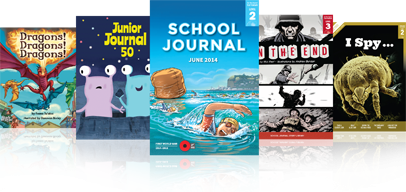
- Gold
- Purple
- Magenta
- Yellow
- 3
- 4
- 2
- 1
- 6
- 4
- 5
- 8
- 7
- 3
- 1
- English
- Social Sciences
- Science
- Health and Physical Education
- Technology
- Mathematics and Statistics
- The Arts
- Non-fiction
- Fiction
- None
- Nature of science
- Geometry and Measurement
- Living world
- Planet Earth and beyond
- Nature of technology
- Physical world
- Number and Algebra
- Statistics
- Technological knowledge
- Material world
- Technological practice
- Engage with science
- Gather and interpret data
- Interpret representations
- Use evidence
- Articles
- Stories
- Poems
Search results
166 items - Showing 41 - 50
-
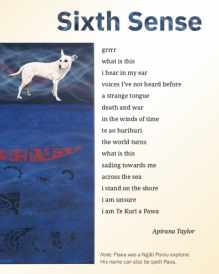
Sixth Sense
by Apirana Taylor
artwork by Steve Gibbs
This thought-provoking poem by Apirana Taylor is a response to an artwork of the same name by Steve Gibbs. The poem and artwork are about the arrival of the Endeavour in 1769 and the enormous change that was about to take place for Māori communities.
-
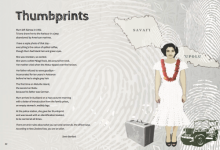
Thumbprints
by Serie Barford
illustrated by Sheyne Tuffery
"Mum left Sāmoa in 1952. To‘ono drove her to the harbour in a jeep abandoned by American marines."
-
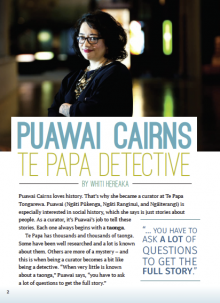
Puawai Cairns: Te Papa Detective
by Whiti Hereaka
This article describes the work of Puawai Cairns, a curator at Te Papa Tongarewa. Puawai believes that as a curator, her job is to tell stories about people: “Each one always begins with a taonga.”
-
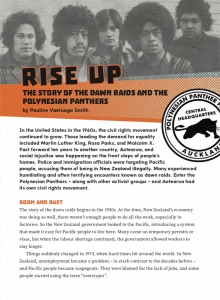
Rise Up: The Story of the Dawn Raids and the Polynesian Panthers
by Pauline Vaeluaga Smith
The article “Rise Up: The Story of the Dawn Raids and the Polynesian Panthers” recounts the story of the dawn raids that took place in Aotearoa in the 1970s. Under instruction from the government of the day, police and immigration officials invaded the homes of Polynesian people in the early hours of the morning, demanding evidence that they were lawfully living in Aotearoa.
-
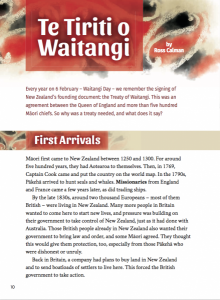
Te Tiriti o Waitangi
by Ross Calman
This straightforward article explains what the Treaty of Waitangi is, why it was needed, and what it says. Although most students will have heard of the Treaty, this may be the first time they have read about it for themselves.
-
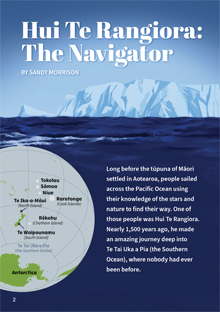
Hui Te Rangiora: The Navigator
by Sandy Morrison
Long before the tūpuna of Māori settled in Aotearoa, people sailed across the Pacific Ocean using their knowledge of the stars and nature to find their way. One of those people was Hui Te Rangiora. Nearly 1,500 years ago, he made an amazing journey deep into Te Tai Uka a Pia (the Southern Ocean), where nobody had ever been before.
-
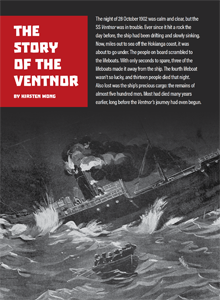
The Story of the Ventnor
by Kirsten Wong
In 1902, thirteen lives were lost when the SS Ventnor sank off the Hokianga coast in Northland. The ship was carrying the carefully packaged bones of almost five hundred Chinese goldminers on their way home for burial. Despite immediate efforts to retrieve the bones, the ship and its precious cargo were lost. Over the following months, some of the bones washed up on Hokianga beaches. Most of these bones were collected and cared for by local iwi, with the stories of the shipwreck and the Chinese kōiwi passed down across generations of Māori. Over one hundred years later, some of the decendants of the goldminers discovered the fate of the bones and the kindness that iwi had shown and travelled north to learn more. A shared respect for the ancestors has since drawn together Chinese New Zealand communities and the iwi who are now kaitiaki of the goldminers’ remains.
-
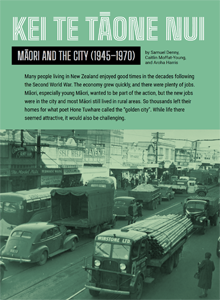
Kei te Tāone Nui: Māori and the City (1945–1970)
by Samuel Denny, Caitlin Moffat-Young, and Aroha Harris
The post-Second-World-War era in Aotearoa New Zealand saw one of the fastest rates of urban migration in the world, with Māori migrating to cities in large numbers to take advantage of new economic opportunities. The “golden city” offered much, but it came at a high price. Despite an unquestioned narrative in Pākehā communities that New Zealand’s race relations were world leading, Māori moving to the city encountered prejudice and discrimination at many levels. Māori responded to these challenges in multiple ways, for example, by establishing formal and informal groups that strengthened collective expression of Māori cultural values and practices. By gathering together to debate and take action on key issues, the seeds were sown for the modern Māori protest movement as well as the forging of a new urban Māori identity.
-
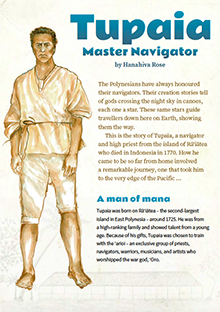
Tupaia: Master Navigator
by Hanahiva Rose
The story of Tupaia, a navigator and high priest from the island of Rā‘iātea.
-

A Hoe!
by Steve Gibbs
The first peaceful meetings between Māori and Europeans took place in 1769, when James Cook landed in the Tairāwhiti region. During those meetings, Māori traded a number of painted hoe (paddles) for cloth, seeds, potatoes, and other items. The paddles are decorated with the earliest examples of what we now call kōwhaiwhai. They ended up in museums around the world.







 Literacy Online home
Literacy Online home
